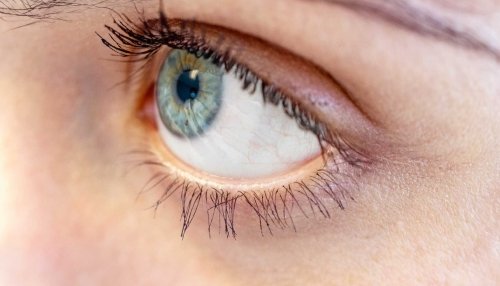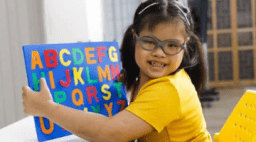What to Expect
Our providers are specially trained in adapting exam techniques to accommodate all children and adults with disabilities. We provide comprehensive examinations in a relaxed, welcoming environment to help ensure our patients have a comfortable and enjoyable experience.
The Eye Institute’s Optical Center includes a variety of frame options specifically designed for children with disabilities.
Common Eye Conditions in Individuals with Disabilities
- Nearsightedness (myopia)
- Farsightedness (hyperopia)
- Eye turns (strabismus)
- Lazy eye (amblyopia)
- Eye focusing
- Eye teaming
- Depth perception
- Eye movements
- Cortical visual Impairment
- Eye health issues, such as cataract or coloboma
Common Vision Conditions
We assist individuals with vision challenges related to down syndrome, cerebral palsy, autism, and cortical visual impairment.
Individuals with Down Syndrome (DS) are more likely to have vision problems. Common eye conditions of individuals with Down Syndrome include:
- Refractive errors -Individuals with DS are much more likely to need glasses.
- Strabismus and Amblyopia – Eye turns and lazy eye are much more common in individuals with DS
- Excess Tearing – Due to blocked or narrow drainage ducts in the eye
- Keratoconus – Thinning of the front surface of the eye, causing it to develop a cone shape and blurry vision that may not be corrected with glasses alone. Can be made worse by eye rubbing.
- Cataracts – Increased risk of congenital cataracts (present at birth) as well as acquired cataracts.
- Nystagmus – Involuntary movements of the eyes.
- Blepharitis – Inflammation of the eyelids that may cause redness and crusting
Individuals with Cerebral Palsy (CP) may have vision problems due to both how the eyes work and how the brain processes visual information (Cortical Visual Impairment). Common vision problems include:
- Hyperopia (Far-Sightedness) – Over half of individuals with CP need some type of vision correction. Hyperopia is the most common
- Strabismus – Studies report that over half of individuals with CP will have some type of eye turn
- Visual Field Loss – Individuals with CP are more likely to suffer from visual field loss, creating blind spots in one or both eyes.
- Eye movement difficulties – Individuals with CP may have difficulty with eye movements typically needed for reading
- Amblyopia – Individuals with CP are more likely to have decreased vision in one or both eyes that cannot be corrected with glasses
In 2019, the Journal of the American Association for Pediatric Ophthalmology and Strabismus reported that it is very common for individuals with autism to have undetected vision problems. Common signs and behaviors of vision problems in autistic individuals include:
- Looking beyond/through objects
- Turning head, or using peripheral vision to view objects rather than central vision
- Eye rolling
- Poor eye contact
- Visual Stimulation (such as flapping fingers in front of eyes or pushing on eyelids)
- Sensitivity to light
- Tracking moving objects accurately
- Difficulty finding an object in a busy environment when a lot of distractions are present
Cortical Visual Impairment (CVI) is decreased vision due to an injury or damage to the visual pathways or visual processing areas of the brain. In other words, CVI causes healthy eyes to have difficulty processing what they see.
- CVI is the most common cause of blindness and low vision in children.
- CVI is extremely underdiagnosed. For every child diagnosed with CVI, there are likely four more who have gone undiagnosed.
- CVI is common in neurodevelopmental conditions and complications from premature birth or lack of oxygen. Many genetic conditions may also potentially lead to CVI.
Common symptoms of CVI include:
- Difficulty focusing on objects, or reaching for objects without looking at them
- Difficulty recognizing faces, even familiar ones
- Difficulty locating objects in a crowded environment
- Reaching for an object while avoiding looking at it
- Reacting slowly to visual cues
- Strong color preferences
- Prefer to look at moving objects more than still ones
- Light gazing



